
The reasons for using biological pest control are numerous and include,
(a) the absence of a re-entry interval (REI) or pre-harvest interval
(PHI), (b) no requirement for an applicator licence, (c) no
phytotoxicity to the crop, and, of course, (d) it is part of
sustainable or “green” growing.
The reasons for using biological pest control are numerous and include, (a) the absence of a re-entry interval (REI) or pre-harvest interval (PHI), (b) no requirement for an applicator licence, (c) no phytotoxicity to the crop, and, of course, (d) it is part of sustainable or “green” growing.
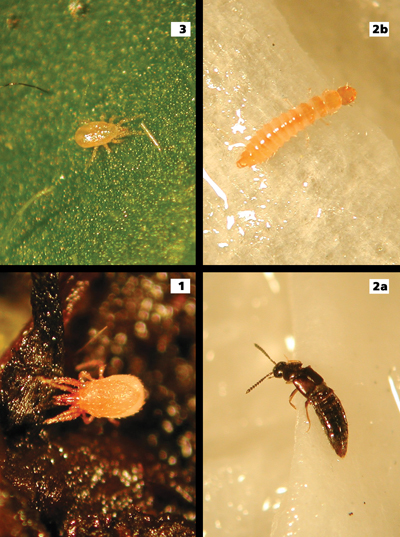 |
|
| [1] Hypoaspis miles, [2a] Atheta coriaria adult and [2b] larva, and [3] Amblyseius cucumeris. Advertisement
|
No matter the reason for turning to biocontrol, all growers have the same questions: “how do I start,” or “how can I make sure I will succeed?” Starting a biocontrol strategy that ensures long-term success can be summarized in two words: “planning” and “prevention.”
Planning: Just as your other production inputs such as fertilizer, seeds, pots, etc., are planned, pest management can and should be planned. Don’t wait until a problem shows up and then look for a solution! The best programs are those based upon biocontrol agents (BCAs) as the “first line of defence.”
REVIEW YOUR PEST PROBLEMS OF PREVIOUS YEARS
So, how do you plan a pest management program based on biocontrol? First, review the pest problems of previous years. Which are the pests associated with each plant grown? When and where do pests usually first show up in the greenhouse?
Once you have identified what you need to control, it’s time to identify which biocontrol agents could be used. So, educate yourself about biocontrol and BCAs. There are many sources of information available, such as books and the Internet, but most importantly, talk to a biocontrol producer or supplier. Ask plenty of questions. A good supplier should give you more than just the list of products he or she wants you to use. They should be able to explain why they are suggesting one particular BCA instead of another. The strategy should be clear and adapted for your situation.
Another step is to review pesticides used the previous year; the last three to four months are most important. Some pesticides leave residues that remain harmful to BCAs for months; therefore, it is necessary to stop using these harsh pesticides well before starting a biocontrol program. This allows the residues to “break down” enough to have little harmful impact.
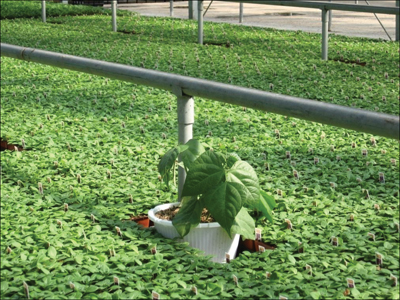 |
|
| A bean trap plant.
|
BCA PROGRAMS OFTEN REQUIRE ‘SOFT’ PESTICIDES
Producers and suppliers of BCAs have lists of pesticides and their effect on BCAs. Because there are pests against which there is no BCA, or conditions where BCAs need some help, it is possible that you may still have to use pesticides. Therefore, while reviewing your pesticide list, it is also a good time to identify “soft” pesticides that are compatible with BCAs and that could be used if the need arises.
What we are talking about here is a true IPM strategy where both biological and chemical pest controls co-exist, a system where biocontrol is the first line of defence supported by precision chemical application.
Prevention: During the process of planning your biocontrol/IPM program, focus on early preventive and proactive actions. Start your program with the introduction of BCAs as early as possible in your crop cycle, even as early as the propagation stage (seeding or sticking cuttings). For example, fungus gnats always appear soon after seeding (or sticking cuttings); therefore, the predatory mite Hypoaspis miles (Picture 1) and the predatory beetle Atheta coriaria (Pictures 2a-2b) can be introduced as soon as trays (or pots) come out of the seeding (or potting) line (or after being placed on tables). These two BCAs can survive without food for some time and will be present when the first fungus gnat eggs and larvae appear.
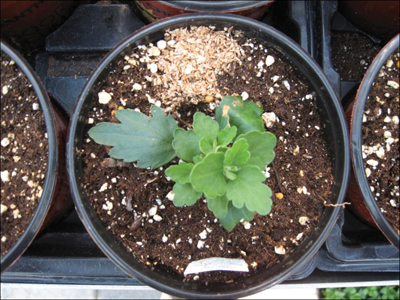 |
|
| A. cucumeris piles
|
HELPING PREDATORS WITH ‘BREEDING MATERIAL’
Another example of a preventive approach is the use of the predatory mite Amblyseius cucumeris against thrips. A. cucumeris (Picture 3) is available in a bran mix that contains food for A. cucumeris and allows it to reproduce. This product is referred to as a “breeding material.” The breeding material is applied as piles onto pots immediately after sticking cuttings (or in plug trays after seeding); when done correctly, A. cucumeris will reproduce in the pile of breeding material (for about four weeks) and will migrate from the pile onto the crop. With this method, a large number of predator mites can be ready before the thrips arrive.
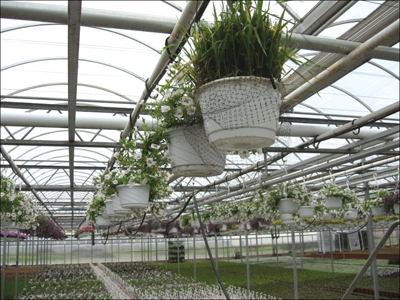 |
| A banker plant (barley with aphids).
|
Another way to act preventively is to use “banker plants,” plants used to rear your own BCAs in the greenhouse. The most common one is a “Colemani Banker-Plant” (pictured), which consists of barley infested with the cereal aphid, Rhopalosiphum padi. The cereal aphid serves as a host to the parasitic BCA Aphidius colemani; the aphid R. padi attacks only monocotyledonous plants such as cereals and grasses but will not attack plants such as peppers, cucumbers, gerberas, mums and most ornamentals plants. With this banker-plant, the parasitic wasp Aphidius colemani population will grow and be present in the greenhouse in high numbers. It will be ready to attack aphids when they appear. In a way, the grower is involved with his or her own production of BCAs, which helps lower the cost of pest control.
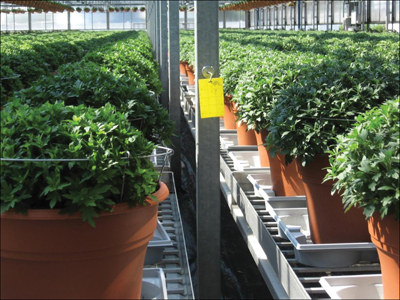 |
|
| Scouting with sticky cards.
|
THE IMPORTANCE OF EARLY DETECTION
With biocontrol, it is very important to detect pest problems early, to know what’s going on in the greenhouse (when pests show up, how pest populations change over time, etc.) in order to react quickly before problems become too severe. Therefore, it is necessary to develop a scouting system adapted for your situation. Scouting includes using sticky traps and plant inspection. It is also possible to use “trap plants,” plants that are more attractive to the pest than the crop. One example of a “trap plant” is the bush bean (picture), which is extremely attractive to spider mites. In most cases, spider mites will be found on the bean plants before the plants in the crop.
All this might seem complicated or overwhelming, but it really is not. Talk to other growers who are using biocontrol to learn about their experiences. They will tell you that not having to spray pesticides is a real time saver, and BCAs are worth it. Get in touch with a biocontrol producer or supplier to discuss your needs and see what they can offer.
With proper planning, a preventive biological control program will be successful and benefit you in the long run. ■
Dominique-Andre Demers is the commercial/technical manager with Biobest Canada Ltd. • dademers@biobest.ca , www.biobest.ca , 519-322-2178
Print this page